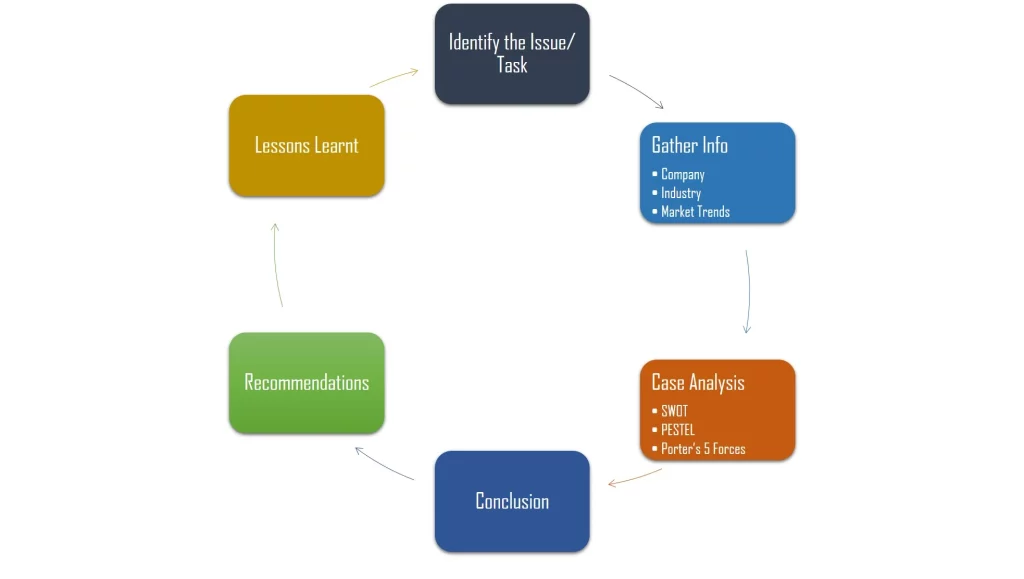Basics
Sample Case Study Papers

A business case study is like a real-world puzzle that gives you a glimpse into a company’s challenges, decisions, and outcomes. It’s a detailed examination of a specific business situation or problem, often used in business schools or professional settings to help analyze and understand complex business issues.
Key Considerations
- Identify the Problem: Clearly understand the central issue or challenge the company is facing. What is the problem they are trying to solve or the decision they need to make?
- Gather Information: Collect relevant data and information about the company, industry, market trends, and any other factors that might influence the situation.
- Analyze the Data: Use analytical tools and frameworks to make sense of the information you’ve gathered. SWOT analysis, Porter’s Five Forces, and PESTEL analysis are some common methods.
- Explore Alternatives: Consider different options or solutions to address the problem. What are the pros and cons of each alternative?
- Make Recommendations: Based on your analysis, propose recommendations for the company. Support your recommendations with solid reasoning and evidence from the case.
- Consider Implementation: Think about how your recommendations can be practically implemented. What challenges might arise during the implementation phase?
- Evaluate Outcomes: Discuss potential outcomes and the impact of your recommendations. How will they affect the company in the short and long term?
- Reflect on Lessons Learned: Consider the broader implications of the case study. What lessons can be drawn from this situation that might be applicable to other businesses or industries?
Remember, a good analysis goes beyond just summarizing the case. It involves critical thinking, application of business concepts, and the ability to articulate well-reasoned recommendations.
Example 1: Netflix’s Entry into Original Content Production
- Background:
- Shift in Business Model:
- Data-Driven Content Creation:
- Strategic Partnerships:
- Global Expansion and Localization:
- Financial Implications:
- Competitive Landscape:
- Subscriber Growth and Retention:
- Challenges and Risks:
- Conclusion:
Example 2: Tesla’s Market Entry and Disruption in the Automotive Industry
- Background:
- Innovation in Electric Vehicles:
- Direct-to-Consumer Sales Model:
- Brand Image and Marketing Strategy:
- Supercharger Network and Charging Infrastructure:
- Autonomous Driving Technology:
- Market Disruption and Industry Impact:
- Financial Performance and Investor Confidence:
- Global Expansion and Production Challenges:
- Conclusion:
Example 3: Amazon’s Evolution from Online Bookstore to E-Commerce Giant
- Background:
- Online Bookstore Origins:
- Diversification into E-Commerce:
- Customer-Centric Approach:
- Introduction of Amazon Prime:
- Marketplace Model and Third-Party Sellers:
- Innovation in Technology and Logistics:
- Expansion into Cloud Computing:
- Global Expansion and Acquisitions:
- Conclusion:
Example 4: Apple’s Innovation Strategy with the iPhone
- Background:
- Product Design and User Experience:
- Touchscreen Technology and Multitouch Interface:
- App Store Ecosystem:
- Integration of Music and Media:
- Continuous Iteration and Hardware Upgrades:
- Global Marketing and Branding:
- Ecosystem Lock-In and Cross-Device Integration:
- Strategic Partnerships and Supply Chain Management:
- Conclusion:
Example 5: Uber’s Disruptive Business Model in the Transportation Industry
- Background:
- Disruptive Business Model:
- SWOT Analysis:
- Strengths:
- Weaknesses:
- Opportunities:
- Threats:
- PESTEL Analysis:
- Political:
- Economic:
- Social:
- Technological:
- Environmental:
- Legal:
- Porter’s Five Forces Analysis:
- Threat of New Entrants:
- Bargaining Power of Buyers:
- Bargaining Power of Suppliers (Drivers):
- Threat of Substitute Products or Services:
- Intensity of Competitive Rivalry:
- Conclusion:
Example 6: Google’s Diversification into Alphabet Inc.
- Background:
- Strategic Motivations for Restructuring:
- SWOT Analysis:
- Strengths:
- Weaknesses:
- Opportunities:
- Threats:
- PESTEL Analysis:
- Political:
- Economic:
- Social:
- Technological:
- Environmental:
- Legal:
- Porter’s Five Forces Analysis:
- Threat of New Entrants:
- Bargaining Power of Buyers:
- Bargaining Power of Suppliers:
- Threat of Substitute Products or Services:
- Intensity of Competitive Rivalry:
- Conclusion:
Example 7: Coca-Cola’s Marketing Strategies for Global Expansion
- Background:
- Brand Consistency and Recognition:
- Localized Marketing Campaigns:
- Sponsorship and Event Marketing:
- Digital Marketing and Social Media:
- Innovation in Product Offerings:
- Partnerships and Collaborations:
- Supply Chain Efficiency and Distribution:
- CSR and Sustainability Initiatives:
- Conclusion:
Example 8: Walmart Strategy Analysis
- Background:
- SWOT Analysis:
- Strengths:
- Weaknesses:
- Opportunities:
- Threats:
- PESTEL Analysis:
- Political:
- Economic:
- Social:
- Technological:
- Environmental:
- Legal:
- Porter’s Five Forces Analysis:
- Threat of New Entrants:
- Bargaining Power of Buyers:
- Bargaining Power of Suppliers:
- Threat of Substitute Products or Services:
- Intensity of Competitive Rivalry:
- Conclusion:
Example 9: IBM’s Transformation from Hardware to Services and Cloud Computing
- Background:
- SWOT Analysis:
- Strengths:
- Weaknesses:
- Opportunities:
- Threats:
- PESTEL Analysis:
- Political:
- Economic:
- Social:
- Technological:
- Environmental:
- Legal:
- Porter’s Five Forces Analysis:
- Threat of New Entrants:
- Bargaining Power of Buyers:
- Bargaining Power of Suppliers:
- Threat of Substitute Products or Services:
- Intensity of Competitive Rivalry:
- Conclusion:
In conclusion, the key to writing a successful business case study analysis paper lies in a thorough understanding of the case, a well-structured analysis, clear and logical recommendations, and a focus on practical implementation. It’s about showcasing your critical thinking skills, supported by evidence from the case, and providing valuable insights for the company’s decision-making process.
